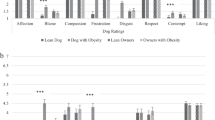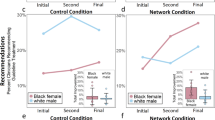Abstract
Objective:
This study examined the independent effect of a patient's weight on medical students’ attitudes, beliefs and interpersonal behavior toward the patient, in addition to the clinical recommendations they make for her care.
Design:
A total of 76 clinical-level medical students were randomly assigned to interact with a digital, virtual female patient who was visibly either obese or non-obese.
Methods:
Interactions with the patient took place in an immersive virtual (virtual reality) clinical environment that allowed standardization of all patient behaviors and characteristics except for weight. Visual contact behavior was automatically recorded during the interaction. Afterward, participants filled out a battery of self-report questionnaires.
Results:
Analyses revealed more negative stereotyping, less anticipated patient adherence, worse perceived health, more responsibility attributed for potentially weight-related presenting complaints and less visual contact directed toward the obese version of a virtual patient than the non-obese version of the patient. In contrast, there was no clear evidence of bias in clinical recommendations made for the patient's care.
Conclusion:
Biases in attitudes, beliefs and interpersonal behavior have important implications because they can influence the tone of clinical encounters and rapport in the patient–provider relationship, which can have important downstream consequences. Gaining a clear understanding of the nature and source of weight bias in the clinical encounter is an important first step toward the development of strategies to address it.
This is a preview of subscription content, access via your institution
Access options
Subscribe to this journal
Receive 12 print issues and online access
$259.00 per year
only $21.58 per issue
Buy this article
- Purchase on Springer Link
- Instant access to full article PDF
Prices may be subject to local taxes which are calculated during checkout


Similar content being viewed by others
References
James PT, Leach R, Kalamara E, Shayeghi M . The worldwide obesity epidemic. Obes 2001; 9: 228S–233S.
Foster GD, Wadden TA, Makris AP, Davidson D, Sanderson RS, Allison DB et al. Primary care physicians’ attitudes about obesity and its treatment. Obes 2003; 11: 1168–1177.
Blumberg P, Mellis LP . Medical students’ attitudes toward the obese and the morbidly obese. Int J Eat Disord 1985; 4: 169–175.
Wiese HJC, Wilson JF, Jones RA, Neises M . Obesity stigma reduction in medical students. Int J Obes 1992; 16: 859–868.
Puhl RM, Heuer CA . The stigma of obesity: a review and update. Obes 2009; 17: 941–964.
Budd GM, Mariotti M, Graff D, Falkenstein K . Health care professionals’ attitudes about obesity: an integrative review. Appl Nurs Res 2010. (e-pub ahead of print 18 September 2009).
Friedman KE, Ashmore JA, Applegate KL . Recent experiences of weight-based stigmatization in a weight loss surgery population: psychological and behavioral correlates. Obes 2008; 16: S69–S74.
Thomas SL, Hyde J, Karunaratne A, Herbert D, Komesaroff PA . Being ‘fat’ in today's world: a qualitative study of the lived experiences of people with obesity in Australia. Health Expect 2008; 11: 321–330.
Carr D, Friedman MA . Is obesity stigmatizing? Body weight, perceived discrimination, and psychological well-being in the United States. J Health Soc Behav 2005; 46: 244–259.
Puhl RM, Moss-Racusin CA, Schwartz MB, Brownell KD . Weight stigmatization and bias reduction: perspectives of overweight and obese adults. Health Educ Res 2007; 23: 347–358.
Merrill E, Grassley J . Women's stories of their experiences as overweight patients. J Adv Nurs 2008; 64: 139–146.
Brown I, Thompson J, Tod A, Jones G . Primary care support for tackling obesity: a qualitative study of the perceptions of obese patients. B J Gen Pract 2006; 56: 666–672.
Anderson DA, Wadden TA . Bariatric surgery patients’ views of their physicians’ weight-related attitudes and practices. Obes 2004; 12: 1587–1595.
Ferrante JM, Chen P-H, Crabtree BF, Wartenberg D . Cancer screening in women: body mass index and adherence to physician recommendations. Am J Prev Med 2007; 32: 525–531.
Drury CA, Louis M . Exploring the association between body weight, stigma of obesity, and health care avoidance. J Am Acad Nurse Pract 2002; 14: 554–561.
Amy NK, Aalborg A, Lyons P, Keranen L . Barriers to routine gynecological cancer screening for White and African-American obese women. Int J Obes 2006; 30: 147–155.
Harvey EL, Hill AJ . Health professionals’ views of overweight people and smoking. Int J Obes 2001; 25: 1253–1261.
Ogden J, Bandara I, Cohen H, Farmer D, Hardie J, Minas H et al. General practicioners’ and patients’ models of obesity: whose problem is it? Patient Educ Couns 2001; 44: 227–233.
Price JH, Desmond SM, Krol RA, Snyder FF, O’Connell JK . Family practice physicians’ beliefs, attitudes, and practices regarding obesity. Am J Prev Med 1987; 3: 339–345.
Campbell K, Engel H, Timperio A, Cooper C, Crawford D . Obesity management: australian general practitioners’ attitudes and practices. Obes 2000; 8: 459–466.
Street Jr RL, Gordon H, Haidet P . Physicians’ communication and perceptions of patients: is it how they look, how they talk, or is it just the doctor? Soc Sci Med 2007; 65: 586–598.
Beach MC, Roter DL, Wang NY, Duggan PS, Cooper LA . Are physicians’ attitudes of respect accurately perceived by patients and associated with more positive communication behaviors? Patient Educ Couns 2006; 62: 347–354.
Dovidio J, Kawakami K, Gaertner S . Implicit and explicit prejudice and interracial interaction. J Pers Soc Psychol 2002; 82: 62–68.
Richeson J, Shelton J . Thin slices of racial bias. J Nonverbal Behav 2005; 29: 75–86.
Roter DL, Frankel RM, Hall JA, Sluyter D . The expression of emotion through nonverbal behavior in medical visits. J Gen Intern Med 2006; 21: S28–S34.
Must A, Spadano J, Coakley EH, Field AE, Colditz G, Dietz WH . The disease burden associated with overweight and obesity. JAMA 1999; 282: 1523–1529.
Miller CT, Rothblum ED, Barbour L, Brand PA, Felicio D . Social interactions of obese and nonobese women. J Pers 1990; 58: 365–380.
Shapiro JR, King EB, Quiñones MA . Expectations of obese trainees: how stigmatized trainee characteristics influence training effectiveness. J Appl Psychol 2007; 92: 239–249.
Talaska CA, Fiske ST, Chaiken S . Legitimating racial discrimination: emotions, not beliefs, best predict discrimination in a meta-analysis. Soc Just Res 2008; 21: 263–296.
Wigton RS, McGaghie WC . The effect of obesity on medical students’ approach to patients with abdominal pain. J Gen Intern Med 2001; 16: 262–265.
Hebl MR, Xu J . Weighing the care: physicians’ reactions to the size of a patient. Int J Obes 2001; 25: 1246–1252.
Persky S, McBride CM . Immersive virtual environment technology: a promising tool for future social and behavioral genomics research and practice. Health Commun 2009; 24: 677–682.
Blascovich J, Loomis J, Beall A, Swinth K, Hoyt C, Bailenson J . Immersive virtual environment technology as a research tool for social psychology. Psychol Inquiry 2002; 13: 103–125.
McCall C, Blascovich J, Young A, Persky S . Proxemic behaviors as predictors of aggression towards black (but not white) males in an immersive virtual environment. Soc Influence 2009; 4: 138–154.
Puhl RM, Schwartz MB, Brownell KD . Impact of perceived consensus on stereotypes about obese people: a new approach for reducing bias. Health Psychol 2005; 24: 517–525.
Schwartz MB, Chambliss HO, Brownell KD, Blair SN, Billington C . Weight bias among health professionals specializing in obesity. Obes 2003; 11: 1033–1039.
Bailenson JN, Blascovich J, Beall AC, Loomis JM . Interpersonal distance in immersive virtual environments. Pers Soc Psychol Bull 2003; 29: 819–833.
Deladisma AM, Cohen M, Stevens AP, Wagner P, Lok BC, Bernard T et al. Do medical students respond empathetically to a virtual patient? Am J Surg 2007; 193: 756–760.
Raij AB, Johnsen K, Dickerson RF, Lok BC, Cohen MS, Duersin M et al. Comparing interpersonal interactions with a virtual human to those with a real human. IEEE Trans Vis Comput Graph 2007; 13: 1–15.
Johnsen K, Raij A, Stevens A, Lind DS, Lok B . The validity of a virtual human experience for interpersonal skills education. Proceedings of the SIGCHI Conference on Human Factors in Computing Systems; 28 April–3 May 2007; San Diego, CA. ACM: New York, 2007.
Epstein RM, Street Jr RL . Patient-Centered Communication in Cancer Care: Promoting Healing and Reducing Suffering. National Cancer Institute NIH Publication No. 07-622, Bethesda, MD, 2007.
Street Jr RL, Makoul G, Arora NK, Epstein RM . How does communication heal? Pathways linking clinician-patient communication to health outcomes. Patient Educ Couns 2009; 74: 295–301.
Zhang W, Moskowitz RW, Nuki G, Abramson S, Altman RD, Arden N et al. OARSI recommendations for the management of hip and knee osteoarthritis, Part II: OARSI evidence-based, expert consensus guidelines. Osteoarthritis and Cartilage 2008; 16: 137–162.
Karnani NG, Reisfield GM, Wilson GR . Evaluation of chronic dyspnea. Am Fam Physician 2005; 71: 1529–1537.
Fazio RH . Multiple processes by which attitudes guide behavior: the MODE model as an integrative framework. In: Zanna MP (ed.) Advances in Experimental Psychology. Academic Press: San Diego, CA, 1990, p. 75–109.
McKinlay JB, Potter DA, Feldman HA . Non-medical influences on medical decision-making. Soc Sci Med 1996; 42: 769–776.
Acknowledgements
This research was supported by the Intramural Research Program of the National Human Genome Research Institute, National Institutes of Health. The authors thank Colleen McBride, Nancy Stevens and Alex Cho for their insightful comments on an earlier version of this paper and Lori Bastian and Greg Feero for their valuable advice. In addition, the authors thank Laura Wagner, Studly Auguste, ShaDonna Jackson and Shea Lott for their assistance in data collection.
Author information
Authors and Affiliations
Corresponding author
Ethics declarations
Competing interests
The authors declare no conflict of interest.
Rights and permissions
About this article
Cite this article
Persky, S., Eccleston, C. Medical student bias and care recommendations for an obese versus non-obese virtual patient. Int J Obes 35, 728–735 (2011). https://doi.org/10.1038/ijo.2010.173
Received:
Revised:
Accepted:
Published:
Issue Date:
DOI: https://doi.org/10.1038/ijo.2010.173
Keywords
This article is cited by
-
Eating Disorder Screening and Treatment in a Medically Underserved Southern State: Data Collected by a Legislative Eating Disorder Council and Implications for Statewide Assessment
Administration and Policy in Mental Health and Mental Health Services Research (2023)
-
The Relationship Between Body Weight and Primary Healthcare Visits
Population Research and Policy Review (2023)
-
Experiences of weight stigmatization in the Israeli healthcare system among overweight and obese individuals
Israel Journal of Health Policy Research (2022)
-
Obesity and the Receipt of Prescription Pain Medications in the US
Journal of General Internal Medicine (2021)
-
Understanding the Co-Epidemic of Obesity and COVID-19: Current Evidence, Comparison with Previous Epidemics, Mechanisms, and Preventive and Therapeutic Perspectives
Current Obesity Reports (2021)



